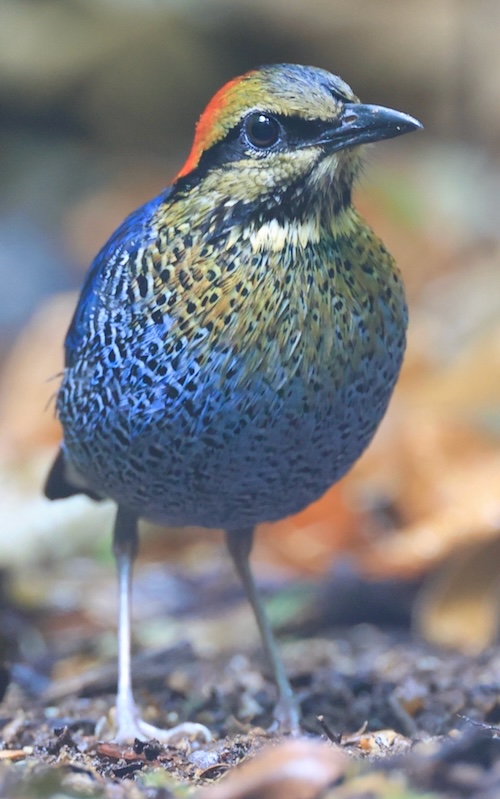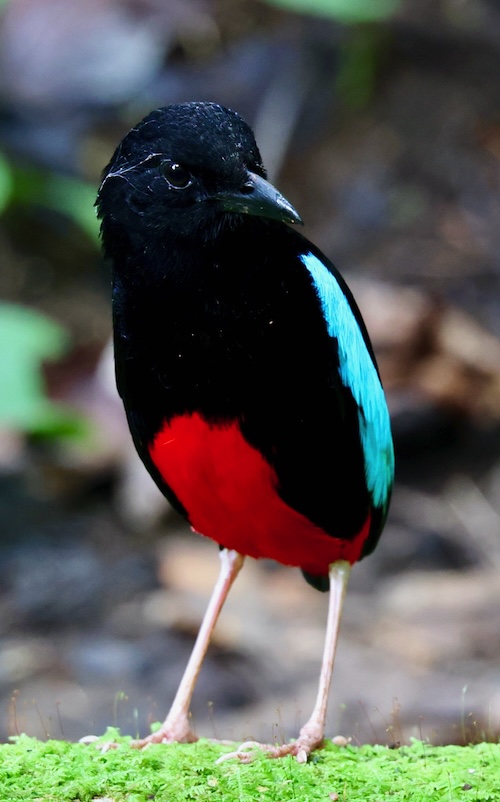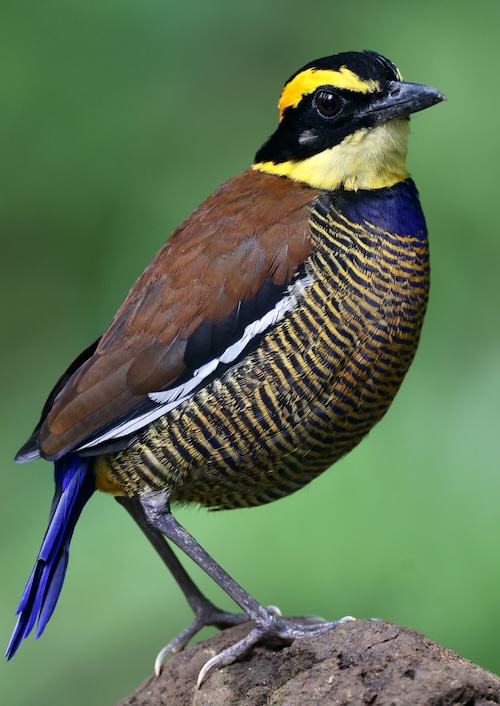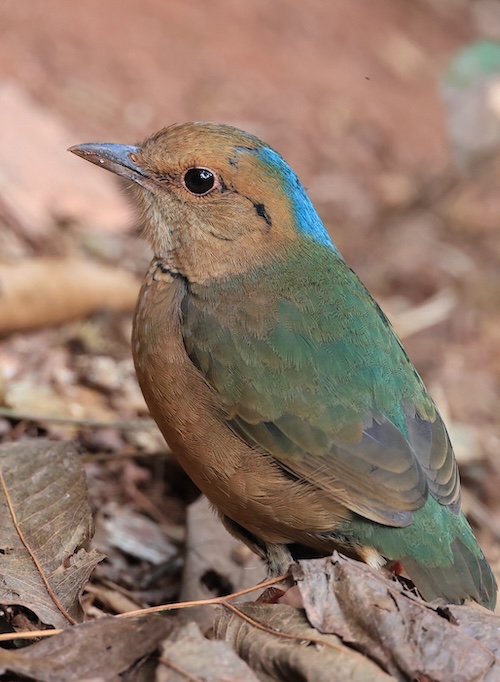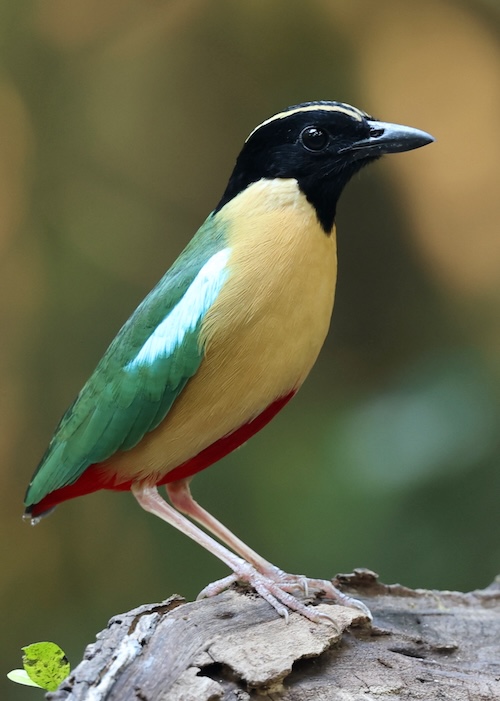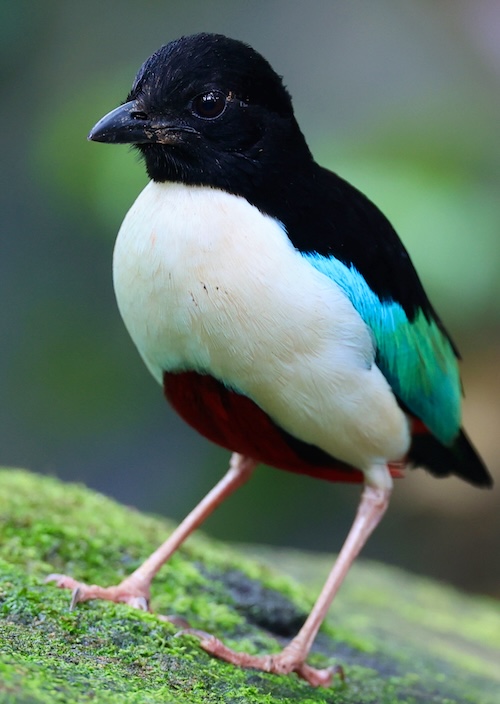Pittidae – Pittas

Pittas are a family, Pittidae, of passerine birds mainly found in tropical Asia and Australasia, although a couple of species live in Africa. The unified world list places Pittidae in linear sequence after the Philepittidae (Asities), the two broadbill families Eurylaomidae (Typical Broadbills) & Calytomenidae (Green & African Broadbills) and Sapayoidae (Sapayoa) (broadly grouped together with those four) and before Pipridae (Manakins).
Pittas are all similar in general structure and habits, and have often been placed in a single genus, although recently (2009) they have been split into three genera; Erythropitta, Hydrornis and Pitta. The name is derived from the word pitta in the Telugu language of South India and is a generic local name used for all small birds. Pittas are medium-sized by passerine standards, at 15cm to 20 cm in length, with stocky build, and strong, longish legs and long feet. They have very short tails and stout, slightly decurved bills. Most, but not all, have brightly coloured plumage.
|
|
|
|
Blue Pitta Hydrornis cyaneus |
Superb Pitta Pitta superba |
|
The two photos above courtesy of ©Nick Ludovic Green Bird-Photo-Tours ASIA |
|
They are fairly terrestrial birds of wet forest floors. They eat snails, insects and similar invertebrate prey. They are mostly solitary and lay up to six eggs in a large spherical nest in a tree or shrub, or sometimes on the ground. Both parents care for the young. Many species of pittas are migratory, and they often end up in unexpected places like house-gardens during migration.
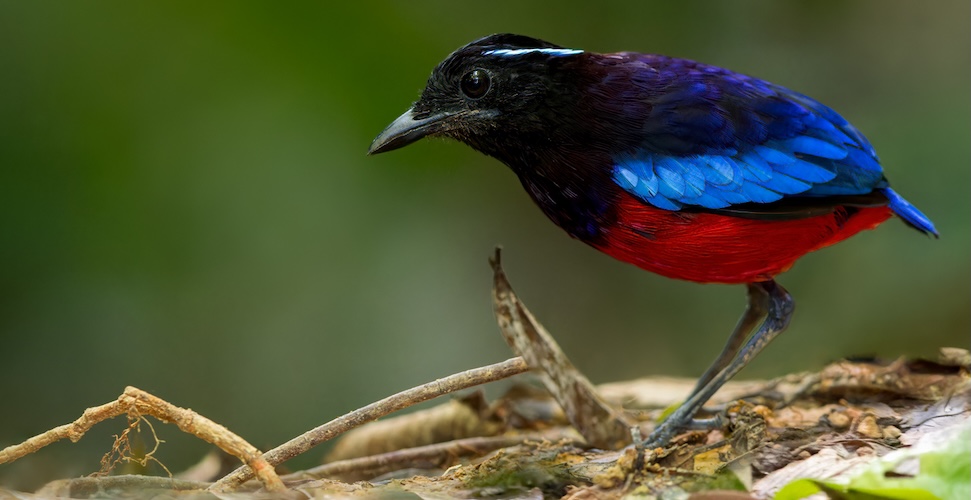
Black-crowned Pitta Erythropitta ussheri – ©Dubi Shapiro
A number of species of pitta are threatened with extinction. One of these, the Gurney’s Pitta, is listed as endangered by the IUCN; a further eight species are listed as vulnerable. The main threat to pittas is habitat loss in the form of rapid deforestation.
|
|
|
|
Javan Banded Pitta Hydrornis guajanus |
Blue-naped Pitta Hydrornis nipalensis |
|
|
|
|
Elegant Pitta Pitta elegans |
Ivory-breasted Pitta Pitta maxima |
|
The two photos above courtesy of ©Nick Ludovic Green Bird-Photo-Tours ASIA |
|
The pittas range in size from the Blue-banded Pitta at 15cm to the Giant pitta, which can be up to 29cm in length; ranging in weight from 42g to 210g. They are all stout bodied birds with long, strong tarsi and long feet. There is considerable variation in the colour of the legs and feet, this may be used by females in judging the quality of males. The wings have ten primaries are generally rounded and short; those of the four migratory species, however, are more pointed. Although pittas are behaviourally reluctant to fly, they are capable and even strong fliers. The tails range from being short to very short, and is composed of twelve feathers.

Blue-headed Pitta Hydrornis baudii – ©Dubi Shapiro
Atypically for forest floor species, the plumage of pittas is often bright and colourful. Only one species, the Eared Pitta, has entirely cryptic colours in the adults of both sexes. In the same genus, three others have drabber than average plumage. Like the other Hydrornis pittas they are sexually dimorphic in their plumage, with the females tending towards being drabber and more cryptic than the males. Across most of the family the brighter colours tend to be on the undersides, with the bright colours on the rump, wings and upper-tail coverts being concealable. Being able to conceal bright colours from predator approach from above is important.
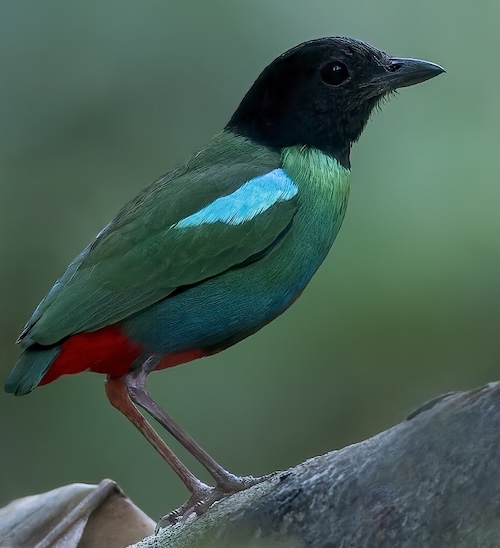
Eastern Hooded Pitta Pitta novaeguineae – ©Dubi Shapiro
The pittas are generally birds of tropical forests, semi-forests and scrub. Of particular importance to most species are forests with lots of cover, a rich understory, and leaf litter for feeding. Pittas often frequent areas near waterways as well. Some species inhabit swamps and bamboos forests, and the Mangrove Pitta, as its name suggests, is a mangrove specialist.

Mangrove Pitta Pitta megarhyncha – ©Andy Walker
A number of species are lowland forest specialists, for example the rainbow pitta is not found above 400m, whereas other species may occur at much higher elevations, for example Rusty-naped Pitta have been found up to 2,600m. This varies in the Fairy Pitta across its range, reaching up to 1,300m in Taiwan, but at much lower levels in Japan. In addition to natural habitats pittas may use human altered habitats, for example migrating Blue-winged Pittas and Hooded Pittas use parks and urban gardens in Singapore and India Pitta is found in gardens in Sri Lanka. The Fairy Pitta migrates from Korea, Japan, Taiwan and coastal China to Borneo. The greatest diversity of pittas is found in South-east Asia. The movements of pittas are poorly known and notoriously difficult to study.
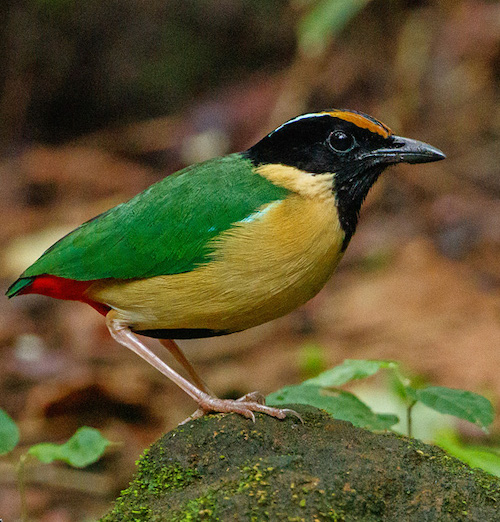
Ornate Pitta Pitta concinna – ©Andy Walker
Pittas are diurnal, requiring light in order to find their often-cryptic prey. They are, nevertheless, often found in darker areas and are highly secretive, though they will respond to imitations of their calls. They are generally found as single birds, with even young birds not associating with their parents unless they are being fed. Small groups have been observed during migration.
They are strongly territorial, with territories varying in size from 3000 m² in the African Pitta to 10,000m² in the Rainbow Pitta. They will perform territory defence displays on the edges of their territories, although fights between rivals have only been recorded once. Migratory species will defend non-breeding feeding territories in addition to their breeding ones.
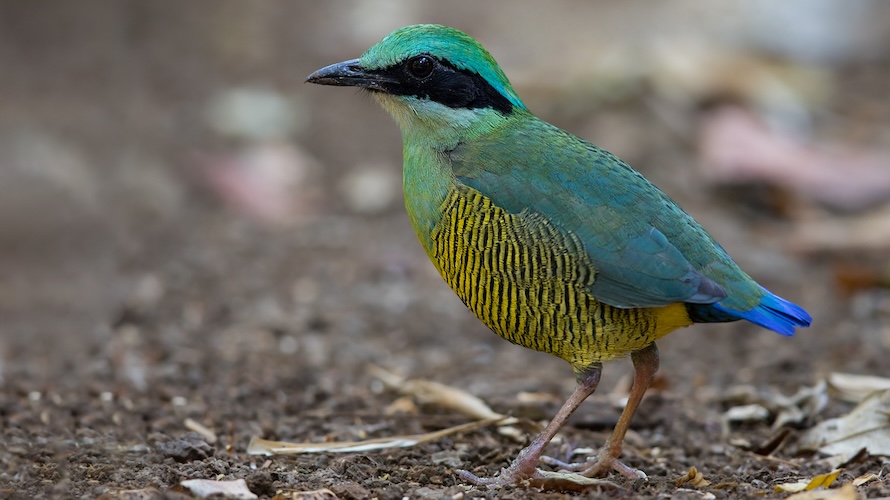
Bar-bellied Pitta Hydrornis elliotii – ©Dubi Shapiro
Earthworms form the major part of the diet of many pittas, followed by snails in order of importance. Earthworms may, however, become seasonally unavailable in dry conditions when the worms move deeper into the soil. In addition, a wide range of invertebrate prey is eaten, including many insect groups such as termites, ants, beetles and lepidopterans; as well as freshwater crabs, centipedes, millipedes, and spiders. In addition to invertebrates some species, such as the Fairy Pitta and Rainbow Pitta, have been recorded feeding on vertebrate prey. In the case of Fairy Pitta, the prey were shrews.
Like most birds, the pittas are monogamous breeders, and defend breeding territories. Most species are seasonal breeders, timing their breeding to occur at the onset of the rainy season. The courtship behaviours of the family are poorly known, but the elaborate dance of the African Pitta includes jumping into the air with a puffed-out breast and parachuting down back down to the perch.

Papuan Pitta Erythropitta macklotii – ©Dubi Shapiro
The pittas build a rudimentary nest that is a dome with a side entrance. The structure of the nest is consistent across the whole family. Both parents incubate the clutch, the period between laying and hatching being between 14 and 18 days (14 to 16 being more typical). The chicks usually hatch asynchronously, over a number of days, but in some species the hatching is synchronous. On hatching the parents of at least two species are reported to consume the eggshells.
According to the unified world list there are 46 species of Pitta in just three genera; they are set out in the species list below. There are two others recognised as full species by some and their final status requires more research.
-
Number of bird species: 46
(As at January 2026)
The jury is still out on two possible species (genera bracketed) pending further research which has led to changes on the unified world list.
Whiskered Pitta Erythropitta kochi
Philippine Pitta Erythropitta erythrogaster
Sula Pitta Erythropitta dohertyi
Sulawesi Pitta Erythropitta celebensis
North Moluccan Pitta Erythropitta rufiventris
South Moluccan Pitta Erythropitta rubrinucha
Papuan Pitta Erythropitta macklotii
Bismarck Pitta Erythropitta novaehibernicae
Louisiade Pitta Erythropitta meeki
Graceful Pitta Erythropitta venusta
Black-crowned Pitta Erythropitta ussheri
Blue-banded Pitta Erythropitta arquata
Garnet Pitta Erythropitta granatina
Eared Pitta Hydrornis phayrei
Rusty-naped Pitta Hydrornis oatesi
Blue-naped Pitta Hydrornis nipalensis
Blue-rumped Pitta Hydrornis soror
Giant Pitta Hydrornis caeruleus
Schneider’s Pitta Hydrornis schneideri
Malayan Banded Pitta Hydrornis irena
Javan Banded Pitta Hydrornis guajanus
Bornean Banded Pitta Hydrornis schwaneri
Blue-headed Pitta Hydrornis baudii
Blue Pitta Hydrornis cyaneus
Bar-bellied Pitta Hydrornis elliotii
Gurney’s Pitta Hydrornis gurneyi
African Pitta Pitta angolensis
Green-breasted Pitta Pitta reichenowi
Indian Pitta Pitta brachyura
Blue-winged Pitta Pitta moluccensis
Fairy Pitta Pitta nympha
Nicobar Hooded Pitta Pitta abbotti
Western Hooded Pitta Pitta sordida
Minahasa Hooded Pitta Pitta forsteni
Eastern Hooded Pitta Pitta novaeguineae
Biak Hooded Pitta Pitta rosenbergii
Azure-breasted Pitta Pitta steerii
Noisy Pitta Pitta versicolor
Ivory-breasted Pitta Pitta maxima
Ornate Pitta Pitta concinna
Elegant Pitta Pitta elegans
Banda Sea Pitta Pitta vigorsii
Black-faced Pitta Pitta anerythra
Mangrove Pitta Pitta megarhyncha
Superb Pitta Pitta superba
Rainbow Pitta Pitta iris
-
Pittas, Broadbills & Asities
| By Frank Lambert & Martin Woodcock | Helm | Edition 2 | 2025 | Hardback | 80 pages, 24 plates with colour illustrations; colour photos, b/w illustrations, colour distribution maps | ISBN: 9781472905697 Buy this book from NHBS.com
-
Pittidae
Family AccountElusive jewels of Asian forests, these striking passerines are adorned in some of the purest colors of any bird, yet their shyness makes them invisible to... -
Pittidae
Family AccountPittas are a family, Pittidae, of passerine birds found in Asia, Australasia and Africa.
Given the number of species in this family, Fatbirder does not provide quick links to all of them. However, the entries below do include links to representatives of every genera, all those illustrated and some of the most often encountered, iconic or sought-after species.
-
African Pitta Pitta angolensis
Species AccountAfrican Pitta Pitta angolensis Found on the floor of forest and dense thicket. Very shy, remaining motionless for long periods. -
African Pitta Pitta angolensis
Species AccountThe African pitta (Pitta angolensis) is an Afrotropical bird of the family Pittidae. It is a locally common to uncommon species... -
African Pitta Pitta angolensis
Species AccountSound archive and distribution map. -
Azure-breasted Pitta Pitta steerii
Species AccountA medium-sized, long-legged bird of lowland and foothill forest floor and undergrowth in the southern Philippines. -
Azure-breasted Pitta Pitta steerii
Species AccountThe azure-breasted pitta (Pitta steerii) is a species of bird in the family Pittidae. It is a striking and colorful bird... -
Azure-breasted Pitta Pitta steerii
Species AccountSound archive and distribution map. -
Banded Pitta Pitta guajana
Species AccountSound archive and distribution map. -
Banded Pitta Pitta guajana
Species AccountThe banded pittas, Hydrornis (guajana) spp., are a group of birds in the Pittidae family that were formerly lumped as a single species, the banded pitta. They are found in forest in the Thai-Malay Peninsula and the Greater Sundas. -
Bar-bellied Pitta Hydrornis elliotii
Species AccountJade-green pitta with densely striped, green underparts and a black mask. Male has an aquamarine-blue patch on the back of the crown and a dark purplish-blue... -
Bar-bellied Pitta Hydrornis elliotii
Species AccountThe bar-bellied pitta (Hydrornis elliotii) is a species of bird in the family Pittidae. It is found in Cambodia, Laos, Thailand, and Vietnam. -
Bar-bellied Pitta Hydrornis elliotii
Species AccountSound archive and distribution map, etc. -
Black-crowned Pitta Erythropitta ussheri
Species AccountDazzling pitta of Borneo's lowland dipterocarp forests. Midnight blue above and blinding scarlet below, with a dark head, bright blue wing coverts. -
Black-crowned Pitta Erythropitta ussheri
Species AccountThe black-crowned pitta (Erythropitta ussheri), also known as the black-headed pitta, black-and-crimson pitta, black-and-scarlet pitta or black-crowned garnet... -
Black-crowned Pitta Erythropitta ussheri
Species AccountSound archive and distribution map, etc. -
Blue Pitta Hydrornis cyaneus
Species AccountThe blue pitta (Hydrornis cyaneus) is a species of bird in the family Pittidae found in the northeastern Indian subcontinent, southern China, and Indochina. -
Blue Pitta Hydrornis cyaneus
Species AccountSound archive and distribution map. -
Blue-banded Pitta Erythropitta arquata
Species AccountSound archive and distribution map, etc. -
Blue-banded Pitta Erythropitta arquata
Species AccountThe blue-banded pitta (Erythropitta arquata) is a species of bird in the family Pittidae. It is endemic to the island of Borneo, where it is found in all three... -
Blue-banded Pitta Erythropitta arquata
Species AccountUnique-looking pitta of hill and submontane forests. -
Blue-headed Pitta Hydrornis baudii
Species AccountSmall and unique gem-like pitta of Borneo's lowland dipterocarp forests—both pristine and logged. -
Blue-headed Pitta Hydrornis baudii
Species AccountThe blue-headed pitta (Hydrornis baudii) is a species of bird in the pitta family Pittidae. It is endemic to Borneo. -
Blue-headed Pitta Hydrornis baudii
Species AccountSound archive and distribution map, etc. -
Blue-naped Pitta Hydrornis nipalensis
Species AccountA rotund, earthen-toned ground-dweller, usually hidden deep in the undergrowth of dense forests, often in damp areas near rivers and streams. -
Blue-naped Pitta Hydrornis nipalensis
Species AccountThe blue-naped pitta (Hydrornis nipalensis) is a species of bird in the family Pittidae. -
Blue-naped Pitta Hydrornis nipalensis
Species AccountSound archive and distribution map, etc. -
Blue-rumped Pitta Hydrornis soror
Species AccountSound archive and distribution map, etc. -
Blue-rumped Pitta Hydrornis soror
Species AccountThe blue-rumped pitta (Hydrornis soror) is a species of bird in the family Pittidae. It is found in Cambodia, China, Laos, Thailand, and Vietnam. -
Blue-rumped Pitta Hydrornis soror
Species AccountShy, earthen-toned groundbird with a rotund, barrel-chested appearance. Both sexes are brown overall with a mossy green back and electric powder-blue nape. -
Blue-winged Pitta Pitta moluccensis
Species AccountA beautiful, rainbow-colored inhabitant of tropical forests; often bolder than other pittas and occasionally seen in city parks... -
Blue-winged Pitta Pitta moluccensis
Species AccountThe blue-winged pitta (Pitta moluccensis) is a passerine bird in the family Pittidae. It forms a superspecies with three other pittas... -
Blue-winged Pitta Pitta moluccensis
Species AccountSound archive and distribution map. -
Bornean Banded Pitta Hydrornis schwaneri
Species AccountSnappy-looking pitta with a broad egg-yolk-yellow eyebrow, black mask, coffee-brown back, and finely barred underparts. -
Bornean Banded Pitta Hydrornis schwaneri
Species AccountThe Bornean banded pitta (Hydrornis schwaneri) is a species of bird in the family Pittidae. It is found only in Borneo. -
Bornean Banded Pitta Hydrornis schwaneri
Species AccountSound archive and distribution map, etc. -
Eastern Hooded Pitta Pitta novaeguineae
Species AccountBeautiful leaf-green pitta of New Guinea and surrounding islands -
Eastern Hooded Pitta Pitta novaeguineae
Species AccountThe eastern hooded pitta (Pitta novaeguineae) is a passerine bird in the pitta family Pittidae that is endemic to New Guinea... -
Eastern Hooded Pitta Pitta novaeguineae
Species AccountSound archive and distribution map. -
Elegant Pitta Pitta elegans
Species AccountSound archive and distribution map. -
Elegant Pitta Pitta elegans
Species AccountThe elegant pitta (Pitta elegans) is a species of passerine bird in the pitta family Pittidae. It is endemic to Indonesia. -
Fairy Pitta Pitta nympha
Species AccountThe fairy pitta (Pitta nympha) is a small and brightly colored species of passerine bird in the family Pittidae. Its diet mainly consists of earthworms... -
Fairy Pitta Pitta nympha
Species AccountA beautiful ground-dweller of well-shaded forests. Adult mostly green above, creamy tan below, with vivid red patch in undertail and central belly and... -
Fairy Pitta Pitta nympha
Species AccountSound archive and distribution map. -
Giant Pitta Hydrornis caeruleus
Species AccountExtremely elusive and rarely-seen ground-dweller; listen instead for its haunting whistle. If seen, overall size and chunkiness alone should be sufficient. -
Giant Pitta Hydrornis caeruleus
Species AccountThe giant pitta (Hydrornis caeruleus) is a species of bird in the family Pittidae. -
Giant Pitta Hydrornis caeruleus
Species AccountSound archive and distribution map. -
Gurney's Pitta Hydrornis gurneyi
Species AccountSound archive and distribution map, etc. -
Gurney's Pitta Hydrornis gurneyi
Species AccountGurney's pitta (Hydrornis gurneyi) is a medium-sized passerine bird. It breeds in the Malay Peninsula, with populations mainly in Myanmar. -
Gurney's Pitta Hydrornis gurneyi
Species AccountHighly range-restricted and declining pitta. Only known healthy population is in far southern Myanmar; now all but functionally extinct in southern Thailand... -
Indian Pitta Pitta brachyura
Species AccountIndian Pitta Pitta brachyura Upperparts are green, with a blue shoulder patch. It is usually seen foraging on forest floors with thick undergrowth, catching... -
Indian Pitta Pitta brachyura
Species AccountThe Indian pitta (Pitta brachyura) is a passerine bird native to the Indian subcontinent. It inhabits scrub jungle, deciduous and dense evergreen forest. -
Indian Pitta Pitta brachyura
Species AccountSound archive and distribution map. -
Ivory-breasted Pitta Pitta maxima
Species AccountThe ivory-breasted pitta (Pitta maxima) is a species of bird in the family Pittidae. It is endemic to North Maluku in Indonesia, known as Paok halmahera. -
Ivory-breasted Pitta Pitta maxima
Species AccountSound archive and distribution map. -
Mangrove Pitta Pitta megarhyncha
Species AccountMangrove Pitta Pitta megarhyncha The huge crab-smashing bill of this mangrove specialist sets it apart from all other pittas. Brightly colored with a black... -
Mangrove Pitta Pitta megarhyncha
Species AccountThe mangrove pitta (Pitta megarhyncha) is a species of passerine bird in the family Pittidae native to the eastern Indian Subcontinent and... -
Mangrove Pitta Pitta megarhyncha
Species AccountSound archive and distribution map. -
Noisy Pitta Pitta versicolor
Species AccountSound archive and distribution map. -
Noisy Pitta Pitta versicolor
Species AccountThe noisy pitta (Pitta versicolor) is a species of bird in the family Pittidae. The noisy pitta is found in eastern Australia and southern New Guinea. -
Noisy Pitta Pitta versicolor
Species AccountA distinctive bird with a chestnut crown. This species has green and black wings, dull yellow underparts, a black facial stripe, a bright blue shoulder patch. -
Ornate Pitta Pitta concinna
Species AccountThe ornate pitta is a species of bird in the family Pittidae. It is found in Indonesia. Its natural habitat is subtropical or tropical moist lowland forest. -
Ornate Pitta Pitta concinna
Species AccountThe ornate pitta (Pitta concinna) is a species of bird in the family Pittidae. It is found in Indonesia. -
Ornate Pitta Pitta concinna
Species AccountSound archive and distribution map. -
Papuan Pitta Erythropitta macklotii
Species AccountA distinctive plump, short-tailed, long-legged bird with a bold red belly. Note the rusty nape, black throat, broad blue chest band bordered below with a thick... -
Papuan Pitta Erythropitta macklotii
Species AccountThe Papuan pitta (Erythropitta macklotii) is a species of pitta. It was formerly considered a subspecies of the red-bellied pitta. -
Papuan Pitta Erythropitta macklotii
Species AccountSound archive and distribution map, etc. -
Philippine Pitta Erythropitta erythrogaster
Species AccountSound archive and distribution map, etc. -
Philippine Pitta Erythropitta erythrogaster
Species AccountThe Philippine pitta (Erythropitta erythrogaster) or blue-breasted pitta, is a species of bird in the family Pittidae. -
Philippine Pitta Erythropitta erythrogaster
Species AccountA plump, short-tailed, long-legged terrestrial bird with a red belly, a black throat, a blue chest band, and a ruddy-colored head. -
Rainbow Pitta Pitta iris
Species AccountRainbow Pitta Pitta iris During breeding season it can be quite vocal, particularly males. This is the only pitta resident in the Top End of the Northern... -
Rainbow Pitta Pitta iris
Species AccountThe rainbow pitta (Pitta iris) is a small passerine bird in the pitta family, Pittidae, endemic to northern Australia... -
Rainbow Pitta Pitta iris
Species AccountSound archive and distribution map. -
Rusty-naped Pitta Hydrornis oatesi
Species AccountRelatively dull for a pitta, but subtly attractive nonetheless. Algae green above and dirt brown below, with a soft orange nape and a thin black line behind... -
Rusty-naped Pitta Hydrornis oatesi
Species AccountThe rusty-naped pitta (Hydrornis oatesi) is a species of bird in the family Pittidae. Rusty-naped pitta. -
Rusty-naped Pitta Hydrornis oatesi
Species AccountSound archive and distribution map. -
Superb Pitta Pitta superba
Species AccountThe superb pitta (Pitta superba) is a large pitta that is endemic to Manus Island which lies to the north of Papua New Guinea. -
Superb Pitta Pitta superba
Species AccountSound archive and distribution map.

